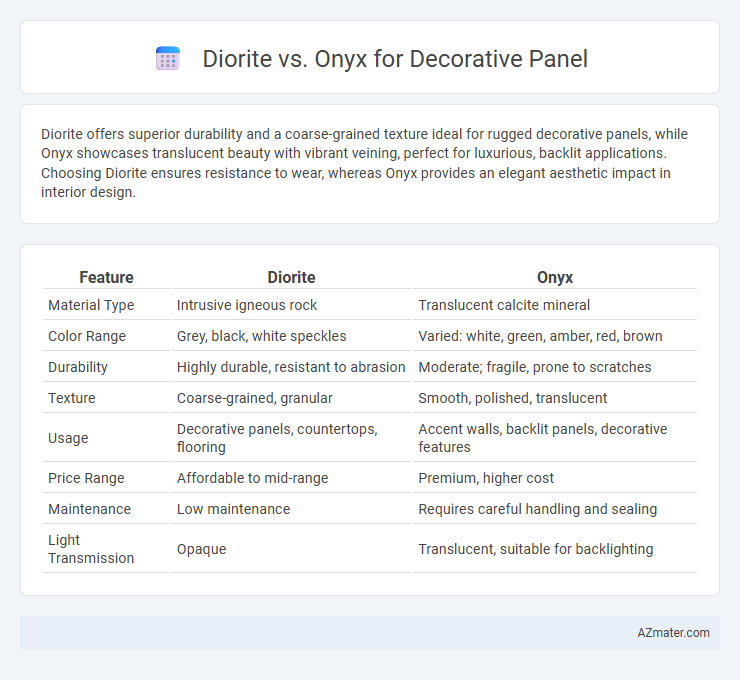Diorite offers superior durability and a coarse-grained texture ideal for rugged decorative panels, while Onyx showcases translucent beauty with vibrant veining, perfect for luxurious, backlit applications. Choosing Diorite ensures resistance to wear, whereas Onyx provides an elegant aesthetic impact in interior design.
Table of Comparison
| Feature | Diorite | Onyx |
|---|---|---|
| Material Type | Intrusive igneous rock | Translucent calcite mineral |
| Color Range | Grey, black, white speckles | Varied: white, green, amber, red, brown |
| Durability | Highly durable, resistant to abrasion | Moderate; fragile, prone to scratches |
| Texture | Coarse-grained, granular | Smooth, polished, translucent |
| Usage | Decorative panels, countertops, flooring | Accent walls, backlit panels, decorative features |
| Price Range | Affordable to mid-range | Premium, higher cost |
| Maintenance | Low maintenance | Requires careful handling and sealing |
| Light Transmission | Opaque | Translucent, suitable for backlighting |
Introduction to Diorite and Onyx
Diorite is a durable, coarse-grained igneous rock known for its speckled black-and-white appearance, making it ideal for decorative panels with a natural, rugged aesthetic. Onyx, a translucent variety of chalcedony, offers striking bands of color ranging from white to deep amber, adding elegance and sophistication to interior designs. Both materials are prized for their unique textures and visual depth, with diorite providing robustness and onyx lending a luxurious, luminous quality to decorative panels.
Geological Origins and Composition
Diorite, an intrusive igneous rock formed from slow cooling magma, primarily consists of plagioclase feldspar, biotite, and hornblende, providing a coarse-grained texture ideal for durable decorative panels. Onyx, a variety of banded chalcedony composed mainly of silica, develops through the deposition of calcium carbonate in volcanic caves or limestone cavities, resulting in a smooth, translucent surface prized for elegant paneling. The contrasting geological origins--igneous versus sedimentary carbonate--underscore diorite's robustness and onyx's aesthetic translucency, influencing their selection in architectural applications.
Visual Aesthetics and Color Variations
Diorite offers a coarse-grained texture with a mix of dark and light mineral patterns, creating a speckled, natural appearance ideal for rustic or industrial decorative panels. Onyx stands out with its translucent quality and vibrant color variations, ranging from creamy whites to deep browns and greens, allowing light to pass through and enhance interior ambiance scenes. The choice between Diorite and Onyx depends on desired visual depth and color dynamics, with Diorite providing bold, textured contrasts and Onyx delivering luxurious, glowing translucency.
Durability and Strength Comparison
Diorite exhibits exceptional durability and strength, making it highly resistant to scratches, heat, and weathering, which suits heavy-use decorative panels. Onyx, while visually striking with its translucent qualities, is softer and more prone to scratches and damage, requiring careful handling in decorative applications. For long-lasting structural performance, Diorite outperforms Onyx in hardness and resistance to wear, ensuring sustained aesthetic appeal in high-traffic areas.
Maintenance and Cleaning Requirements
Diorite panels offer low maintenance due to their natural resistance to scratches and stains, requiring only regular wiping with a damp cloth and mild detergent. Onyx panels demand more careful cleaning, as they are porous and sensitive to acidic or abrasive substances, necessitating gentle cleaning products and frequent sealing to preserve their polished appearance. Both materials require prompt spill cleanup, but Onyx's vulnerability to etching makes its upkeep more intensive compared to the durable diorite surface.
Cost and Market Availability
Diorite generally costs less than Onyx due to its more abundant availability and widespread extraction sources, making it a budget-friendly option for decorative panels. Onyx commands a higher price because of its rarity, unique translucency, and complex quarrying process, often limiting its market availability to specialized suppliers. The demand for Onyx in luxury interiors drives its premium cost, whereas Diorite's durability and broader supply contribute to its cost-effectiveness and easier procurement.
Environmental Impact and Sustainability
Diorite, a durable igneous rock, offers excellent environmental benefits due to its natural abundance and minimal processing requirements, which reduce carbon emissions during extraction and fabrication. Onyx, while visually striking and translucent, typically demands more intensive quarrying and chemical treatments, leading to higher environmental impact and reduced sustainability. Choosing Diorite for decorative panels supports eco-friendly construction practices through its longevity and lower ecological footprint compared to Onyx.
Best Applications for Decorative Panels
Diorite offers exceptional durability and a speckled, granite-like appearance, making it ideal for high-traffic decorative panels in commercial spaces and modern interior walls where toughness and a natural aesthetic are essential. Onyx features a translucent quality with vibrant color veins, perfect for backlit decorative panels in luxury interiors like hotel lobbies, feature walls, and upscale retail environments where visual impact and elegance are priorities. Both stones provide unique texture and visual appeal, but Diorite excels in durability-focused applications while Onyx is best suited for artistic, light-enhanced panel designs.
Design Trends: Diorite vs. Onyx
Diorite offers a speckled, granular texture that complements contemporary and minimalist design trends, while Onyx is prized for its striking translucency and bold veining, fitting luxurious and statement-making interiors. The rising demand for natural stone panels highlights Diorite's durability and subtle elegance in commercial spaces, whereas Onyx's vibrant patterns and backlit capabilities cater to high-end residential and hospitality projects. Designers increasingly choose Onyx for accent walls and lighting features, whereas Diorite remains preferred for sleek, modern surface finishes.
Choosing the Right Stone for Your Project
Diorite boasts a speckled, coarse-grained appearance with high durability and resistance to scratches, making it ideal for heavy-use decorative panels in both indoor and outdoor settings. Onyx offers a translucent, smooth surface with vibrant, swirling patterns that create luxurious, eye-catching focal points but requires careful sealing and maintenance due to its softness and sensitivity to acids. Selecting the right stone depends on balancing Diorite's robustness with Onyx's aesthetic appeal based on project demands, environmental exposure, and desired visual impact.

Infographic: Diorite vs Onyx for Decorative Panel
 azmater.com
azmater.com